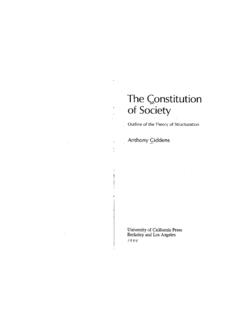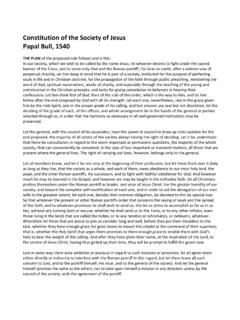Transcription of A New Era of DNA Collections: At What Cost to Civil Liberties?
1 0 A New Era of DNA Collections: At What Cost to Civil liberties ? By Tania Simoncelli and Sheldon Krimsky September 2007 The American constitution society takes no position on particular legal or policy initiatives. All expressions of opinion are those of the author or authors. ACS encourages its members to express their views and make their voices heard in order to further a rigorous discussion of important issues. 1 A New Era of DNA Collections: At What Cost to Civil liberties ? Tania Simoncelli* and Sheldon Krimsky** On January 5, 2006, a little-noticed piece of legislation entitled the DNA Fingerprint Act of 2005 was signed into law by President George W. Bush, greatly expanding the government s authority to collect and permanently retain DNA These ninety-nine lines of text, introduced initially by Senator Jon Kyl [R-AZ], slipped virtually unnoticed through the halls of Congress, buried in the back of the broadly popular, 284-page Violence Against Women Act (VAWA) reauthorization bill.
2 Notwithstanding the lack of public reaction and policy debate, this new law raises extraordinary questions for the future of Civil liberties . Among other provisions, it grants the government authority to obtain and permanently store DNA from anyone who is arrested as well as citizens detained under federal authorities. This change in the federal DNA databanking law is emblematic of a new era in forensic DNA one that is wrought with serious Civil liberties and privacy concerns and may ultimately do little to make people safer. While DNA testing was initially introduced into the criminal justice system as a method of developing supplemental evidence to be used in convicting the guilty or freeing the innocent, in the last fifteen years this has changed. The federal government and all fifty states have created permanent collections of DNA taken from ever-widening categories of persons and subjecting these collections to routine searches.
3 At the same time, a stunning array of techniques have emerged allowing lab technicians to glean information from DNA that goes well beyond the mere identification of a person, while the ability to detect and process minute amounts of DNA has steadily increased as costs have declined. Law enforcement s use of these tools to search, profile and store the DNA of those who have not been convicted of a crime, without a court order or individualized suspicion, has already exceeded reasonable constitutional protections. In particular, a number of new genetic techniques and practices are providing law enforcement unprecedented access into the private lives of innocent persons by way of their own genetic data. These include: 1) a growing trend towards the permanent retention of DNA from innocent people in forensic DNA databanks; 2) trolling for suspects using DNA dragnets; 3) searching for partial matches between crime scene evidence and DNA banks to obtain a list of possible relatives for DNA analysis ( familial searching ); 4) constructing probabilistic phenotypic profiles of a perpetrator from DNA collected at a crime scene; and 5) surreptitiously collecting and searching DNA left behind on items such as cigarette butts and coffee cups.
4 * Technology and Science Fellow, The American Civil liberties Union. ** Professor of Urban & Environmental Policy & Planning, School of Arts and Sciences at Tufts University; Adjunct Professor, Department of Public Health and Family Medicine at the Tufts School of Medicine. 1 The DNA Fingerprint Act of 2005 was signed into law as Title X of the Violence Against Women Act (VAWA), 3402, 109th Cong. (2006) (enacted). 2 This essay explores each of these developments and their implications for Civil liberties . We argue that the availability and use of these techniques seriously violates the reasonable expectations of privacy held by law-abiding citizens regarding their DNA. Developing technology, rather than constitutional analysis and informed public decisionmaking, is driving the expansion of DNA databanks. Neglected to date has been a responsible national debate leading to an understanding of the issues and/or resulting in a societal consensus about the variety of uses of DNA discussed in this paper.
5 To help advance the discussion, we urge that policies on DNA-forensic technologies need to calibrate the proper balance of Civil liberties and law enforcement needs. We argue that clear national guidelines are needed to set standards for what governmental authorities, as well as private companies and individuals, may and may not do with DNA. We hope to provide a context for re-assessing these and other practices that raise serious Civil liberties concerns. Finally, we briefly suggest what some of those guidelines should be. I. Genetic Privacy A person s DNA contains a vast amount of information. Those who argue vigorously for collecting and databanking DNA often compare this process to that of collecting and databanking fingerprints. However, fingerprints differ significantly from biological samples that provide DNA. Fingerprints are two-dimensional images of the raised portion of the epidermis of the fingertips.
6 All of the information available from a fingerprint is there to be examined visually once the impression is made of the finger or the copy of the impression left by someone on an object is made. Using the visible individualized characteristics of a fingerprint, it can be used fairly effectively to identify a person. By contrast, DNA, which must be extracted from a tissue sample and mined for data, contains exactly the kind of information that raises privacy and other Civil liberties concerns. Research conducted to expand our knowledge of what can be revealed by examining a person s DNA continues; as of this writing, samples of DNA can provide insights into familial connections, physical attributes, genetic mutations, ancestry and disease predisposition. As science advances, the phenotypic information available from human DNA will necessarily grow. Genetic information could be used in discriminatory ways and may include information that the person whose DNA it is does not wish to know.
7 Repeated claims that human behaviors such as aggression, substance addiction, criminal tendency, and sexual orientation can be explained by genetics render law enforcement s collection, use and retention of DNA potentially prone to abuse. When DNA testing was first introduced into the criminal justice system in the late 1980s, the extent of our knowledge of associations between genes and diseases or other characteristics was quite limited. This changed significantly with the completion of the rough draft of the human genome sequence in 2000 and the final version in 2003. The completion of the project has greatly accelerated research pertaining to the genetic underpinnings of health and disease. Today, clinical testing is possible for more than 3 1,000 genetic This illustrates the growing reservoir of information contained in our DNA that would ordinarily be covered under medical privacy statutes.
8 The highly sensitive nature of the information in our DNA has been widely recognized. For the past two years, the Senate has unanimously approved legislation that seeks to protect individuals from genetic discrimination in the contexts of employment and health When introducing the Senate bill on genetic discrimination this year, Senator Edward Kennedy [D-MA] noted, It is difficult to imagine information more personal or more private than a person s genetic makeup. 4 The Fourth Amendment of the constitution guarantees the right of the people to be secure in their persons, houses, papers, and effects, against unreasonable searches and seizures. 5 The conduct of a search generally requires probable cause and a judicial warrant, or at least individualized suspicion. courts have consistently found that the collection and analysis of one s DNA constitutes a search for two reasons.
9 First, bodily intrusion is necessary for collecting a blood or buccal swab sample for use in DNA testing. Second, the substantial and uniquely personal information contained in the DNA itself has been found to trigger protections guaranteed under the Fourth At the same time, though, courts have upheld the operation of convicted-offender DNA databanks including the forcible extraction and banking of DNA for one of two reasons: because the government s interest is one of special needs, beyond the normal need for law enforcement 7 or because convicted felons have a diminished expectation of privacy, as balanced against society s need to promote law and Arguably, the role of DNA databanks for convicted felons is for precise identification and for helping police solve recidivist crimes. Even if these rulings upholding offender databanks (which include biological samples)9 are correct (and we do not necessarily concede that they are), they do not 2 See Genetics and Public Policy Center, Issue Brief: FDA regulation of genetic tests, (scroll down; follow FDA regulation of genetic tests hyperlink).
10 3 Legislation to ban genetic discrimination was first introduced in the 104th Congress in 1996. The bill under current consideration is S. 358, the Genetic Information Nondiscrimination Act of 2007, introduced by Senator Snowe. S. 358, 110th Cong. (2007). 4 153 Cong. Rec. S847 (2007) (statement of Sen. Kennedy). 5 CONST. amend. IV. 6 See, , Jones v. Murray, 962 302, 306 (4th Cir. 1992); for a detailed overview of legal challenges relevant to DNA testing and retention, see Mark A. Rothstein & Sandra Carnahan, Legal and Policy Issues in Expanding the Scope of Law Enforcement DNA Data Banks, 67 BROOK. L. REV. 127 (2001). 7 State v. Olivas, 856 1076, 1085 (Wash. 1993) (upholding the Washington DNA testing statute, stating that the purpose of the DNA data bank was to deter and prosecute recidivist acts, and that this purpose was a special need of government beyond normal law enforcement). 8 See, , Landry v. Att y Gen., 709 1085, 1092 (Mass.)









